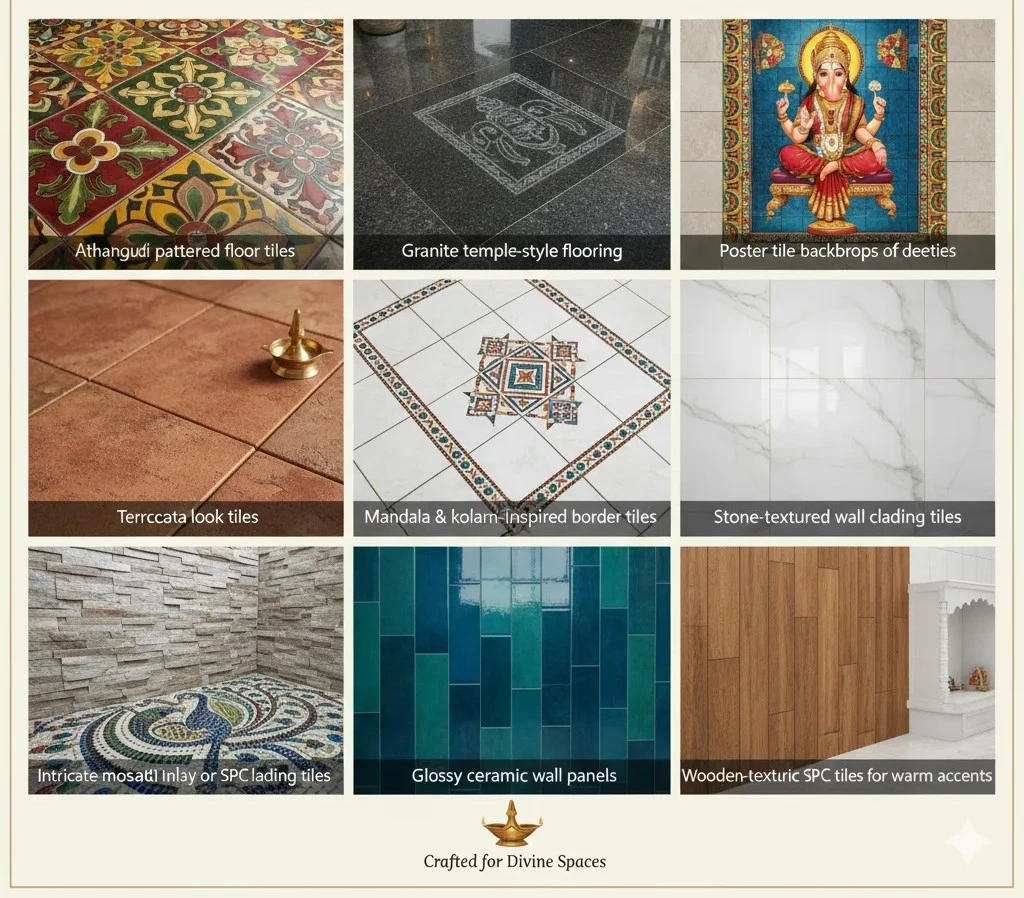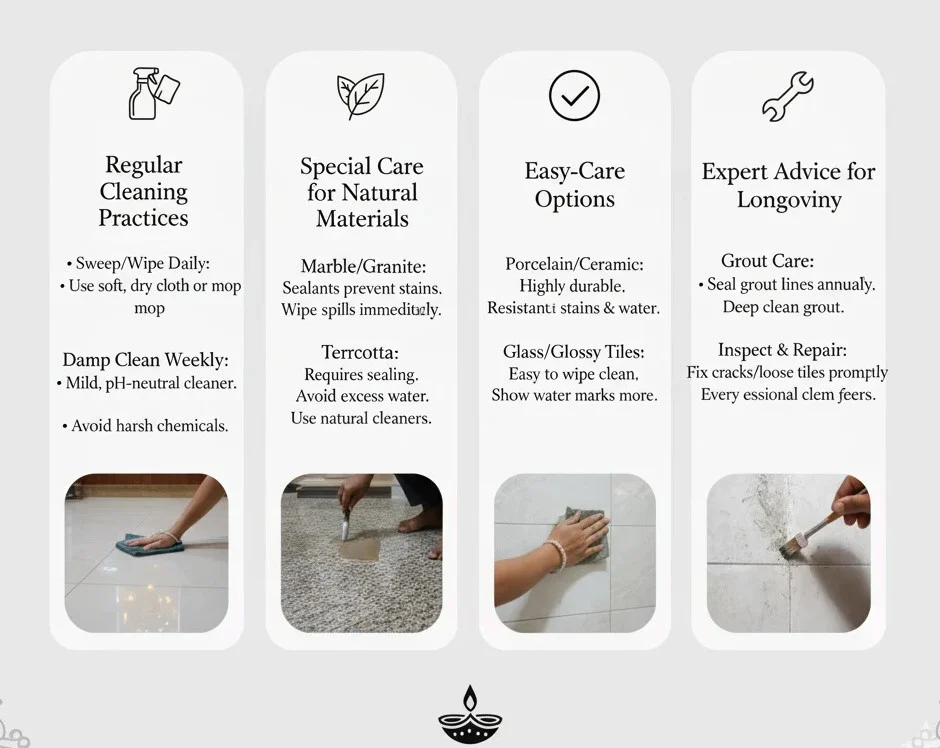Oct 05, 2025
Connect With Our Team
Top 10 Pooja Room Tile Design Ideas for Your Home
- Home
- Utilities
- News & Blog
Introduction to Spiritual Spaces
Creating a Sacred Corner at Home
A pooja room is one of the most serene and peaceful spaces in Indian modern homes. The pooja room often serves as the spiritual centre of the home, providing a focal point for family devotion. It is not just a corner but a dedicated sanctuary where family members gather for prayer, meditation, and performing rituals. By thoughtfully planning this space, homeowners can cultivate an environment that nurtures mindfulness, positivity, and spiritual well-being.
Role of Tiles in Pooja Rooms
The choice of tiles whether ceramic tiles, athangudi tiles, or granite tiles helps create the right spiritual ambiance. The right tiles can enhance the spiritual atmosphere and overall feel of the pooja room by adding beauty, harmony, and calmness. High-quality tiles act as the backdrop for idols, lamps, bells, and décor, setting the tone for the room and influencing how light and energy flow within the area.
Beauty and Elegance in Spiritual Spaces
Selecting the right tiles not only enhances the beauty and elegance of the space but also makes it inviting and sacred for daily rituals. Harmonious patterns and soothing colour palettes can make the pooja room feel more grounded and peaceful, which encourages longer and more meaningful prayer sessions.
Significance in South Indian Homes
In South Indian homes, pooja rooms are an integral part of the house. They are often centrally located or placed in auspicious directions according to Vastu, demanding careful consideration of tile design, colours, and patterns to maintain serenity and spiritual balance.
Guidance from Interior Designers
Experienced interior designers can help homeowners choose the perfect tiles that reflect the spiritual significance of the space and complement the overall home design. Designers also advise on lighting, storage, and seating so that the entire environment supports devotion and meditation.
Traditional South Indian Elements
Roots of Spiritual Design
Traditional South Indian home design often incorporates athangudi tiles, terracotta tiles, and granite tiles to bring elegance and spirituality to interiors. Many traditional South Indian houses feature a central courtyard, which serves as a focal point and enhances natural light and ventilation. These materials have been used for centuries in temples and heritage homes, making them synonymous with sacredness and authenticity. The unique style of South Indian homes is reflected in their use of traditional tiles and architectural elements.
Importance of Intricate Designs
Intricate designs and traditional touches are essential to create a peaceful and inviting atmosphere in the pooja room. Homeowners can decorate their pooja rooms with traditional South Indian motifs and patterns to enhance the spiritual atmosphere. Patterns inspired by nature, such as lotuses, peacocks, or geometric mandalas, can be etched or printed on tiles to echo temple art and cultural symbolism.
Natural Materials in Sacred Spaces
Using natural materials such as wood and stone enhances the spiritual ambiance and blends with the timeless South Indian aesthetic. Wooden ceilings with carved beams or stone plinths for idols can complement the tiled floors and walls beautifully.
Modern Additions with Traditional Soul
In modern times, ceramic tiles and cement tiles have become popular choices for both flooring and wall tiles in South Indian homes. These tiles provide traditional patterns in contemporary finishes, offering durability, water resistance, and easier cleaning without losing the essence of heritage.
Types of Tiles for Pooja Rooms
Top 10 Pooja Room Tile Design Ideas for South Indian Homes
-
Athangudi patterned floor tiles
-
Granite temple-style flooring
-
Poster tile backdrops of deities
-
Terracotta look tiles
-
Mandala & kolam-inspired border tiles
-
Stone-textured wall cladding tiles
-
White marble-look porcelain tiles
-
Glossy ceramic wall panels
-
Intricate mosaic inlay tiles
-
Wooden-texture ceramic or SPC tiles for warm accents

Ceramic Tiles
Ceramic tiles are a popular choice for pooja rooms because of their durability, ease of maintenance, and versatility. Available in glossy, matte, textured, and patterned styles, ceramic tiles can replicate marble, stone, or even handcrafted motifs at a fraction of the cost, making them ideal for homeowners who want a sophisticated yet practical option. Ceramic tiles are an affordable option for many homeowners, offering style without a high price tag. Additionally, ceramic tiles are resistant to stains, making them easy to maintain and keeping your pooja room looking pristine.
Athangudi Tiles
Handcrafted in Athangudi village in the Chettinad region of Tamil Nadu, these tiles are known for their unique designs and vibrant colours. Every tile is individually cast and sun-dried, reflecting artisanal skill. These tiles are manufactured using traditional methods, avoiding modern firing techniques, and river sand is a key ingredient in their making, contributing to their durability and finish. Due to their handmade nature, it is important to have skilled masons install Athangudi tiles, as proper laying techniques ensure stability and aesthetic appeal. Athangudi tiles are often polished to a high sheen, allowing them to reflect light and brighten the pooja room. Using athangudi tiles in your pooja room supports local craftsmen and instantly lends a distinctive, culturally rich look.
Granite Tiles
Granite tiles remain a timeless option, offering elegance, sophistication, and easy maintenance. Their natural speckles and veins create visual depth. Granite is also resistant to wear and moisture, making it perfect for areas where oil lamps or incense might be used regularly. Granite tiles are particularly suited for pooja rooms due to their durability and resistance to moisture. They are also suitable for both traditional and modern pooja room designs.
Poster Tiles
Poster tiles are specially printed tiles that display devotional images, motifs, or patterns such as deities, temple architecture, or traditional symbols. These are especially popular as a backdrop for idols or as accent walls inside the pooja room. Poster tiles allow homeowners to personalize the space with meaningful visuals without having to hang separate frames or artworks. They are available in ceramic, vitrified, and glass finishes for different budgets and effects.
Wall Tiles as Accents
Using wall tiles to create a frame around the pooja area or as a backsplash behind idols adds visual interest and reinforces the spiritual significance of the space. You can also combine neutral base tiles with a border of traditional motifs to highlight the sanctum.
Design Ideas for Modern Homes
Blending Tradition and Modernity
In modern homes, pooja rooms can seamlessly blend traditional and contemporary elements, creating a unique and inviting spiritual space. Incorporating traditional South Indian furniture, such as carved wooden stools or shelves made from rosewood, teak, or jackfruit wood, can further enhance the authenticity of the pooja room. For example, a sleek white cabinet with carved wooden doors can be paired with glossy ceramic tiles to fuse minimalism and heritage.
Bright Colours and Patterns
Incorporating bright colours and patterns can add warmth and elegance to the pooja room while reflecting South Indian vibrancy. Yellows, oranges, and deep reds can energize the space, while blues and greens bring calmness choose tile shades accordingly.
Natural Inspirations
South Indian home design often inspires the use of natural materials and intricate motifs, which can be adapted for compact urban homes. For instance, a small city apartment may feature a pooja corner lined with stone-look ceramic tiles and wooden shelves to mimic a temple feel.
Professional Guidance
Interior designers help create harmony between traditional and modern elements, ensuring the pooja room looks cohesive within the home’s overall décor. They can also recommend anti-slip flooring and easy-clean finishes for practical upkeep.
South Indian Home Design
Signature Tile Choices
Traditional South Indian houses across India frequently feature athangudi tiles, terracotta tiles, and granite tiles as key design components. These tiles are integral to the cultural identity of houses in South India, reflecting the region's heritage and craftsmanship. These materials connect modern households to their cultural roots and help maintain a cool indoor temperature in warm climates.
Beauty Through Natural Materials
The use of wood and stone adds beauty and elegance to interiors, echoing traditional craftsmanship. The entrance to the pooja room or home is often adorned with carved wooden doors and decorative elements, setting a spiritual tone. Carved wooden pillars, stone ledges, and tiled steps leading up to the pooja space create a gradual transition from the mundane to the sacred.
Spiritual Elements in Pooja Rooms
Pooja rooms in South Indian homes are designed to incorporate spiritual elements such as detailed carvings, lamp niches, and traditional flooring. Even the doorframes are often decorated with brass bells or motifs to set a devotional mood.
Contemporary Options
For a modern and sleek look, ceramic tiles and cement tiles can be used while still maintaining a traditional essence through patterns and colours. For instance, geometric temple motifs printed on porcelain tiles combine the best of both worlds.
Pooja Room Design
Adding Spiritual Significance
A well-designed pooja room adds to the spiritual significance of the entire home, creating a serene and inviting atmosphere for prayer. The space can be enhanced further by aligning it with Vastu principles and using uplifting colours.
Enhancing Beauty and Elegance
The thoughtful use of colours, patterns, and textures enhances both the beauty and the sanctity of the space. Mosaic inlays, patterned borders, and subtle contrasts between wall and floor tiles give depth and character.
Timeless Tile Combinations
Combining granite tiles and athangudi tiles can create a timeless and sophisticated look, blending durability with heritage. You might lay granite on the floor for strength and frame the altar with a band of colourful athangudi for a striking focal point.
Warmth Through Wall Tiles
Using wall tiles with subtle textures or traditional motifs adds warmth and elegance, making the space more devotional. Tiles that mimic sandstone or marble can also make small pooja corners appear larger and brighter.
Harsha Tiles is a trusted tile manufacturer and supplier in South India, known for its diverse portfolio that caters especially well to pooja room tile designs. From intricately detailed traditional motifs that reflect South Indian temple aesthetics to clean, contemporary styles for modern prayer spaces, Harsha Tiles covers every design preference. The brand offers tiles in multiple sizes and finishes – matte, glossy, textured, and anti-skid – ensuring homeowners can create serene, elegant, and durable pooja rooms that align with their personal taste and architectural style.
Tile Maintenance for Pooja Rooms

Regular Cleaning Practices
Regular maintenance is essential to keep tiles looking their best, especially in high-use areas like pooja rooms, bathrooms, and kitchens. Simple daily wiping of oil or incense residue prevents staining and keeps surfaces pristine.
Special Care for Natural Materials
Natural materials such as wood and stone require special care regular sealing, gentle cleaners, and avoiding harsh chemicals to maintain their beauty and elegance. Using coasters under lamps and mats under idols can help protect surfaces.
Easy-Care Options
Ceramic tiles and cement tiles are relatively easy to maintain, making them popular choices for both flooring and wall applications in sacred spaces. A mild pH-neutral cleaner and soft cloth are usually enough for daily upkeep.
Expert Advice for Longevity
Interior designers and tile suppliers can provide guidance on tile maintenance to ensure the longevity and spiritual appeal of the pooja room. They can also suggest anti-stain sealants for porous materials like terracotta.
Additional Tips for a Beautiful Pooja Room
Lighting and Décor
Appropriate lighting, such as warm LED lamps, recessed ceiling lights, or traditional brass oil lamps, can highlight the tile work and add to the divine aura. Soft illumination also enhances the colours and textures of the tiles.
Space Optimization
For compact homes, consider built-in shelves or niches within tiled walls to display idols without clutter. This maximizes functionality while keeping the focus on the sacred area.
Sustainable Choices
Opt for eco-friendly tiles like recycled ceramic or locally made athangudi tiles to align with sustainable living values. This not only reduces your carbon footprint but also celebrates regional craftsmanship.
Coordinating Colours
Choose tile colours that harmonize with your idols, prayer accessories, and décor for a cohesive and calm atmosphere. Neutral bases with bold accent tiles can achieve balance without overwhelming the senses.
Why Tile Selection Matters in Spiritual Spaces
Emotional Connection
Tiles are more than just a surface they form part of the emotional and spiritual connection with the pooja room. The right textures and hues can elevate prayer experiences and instill a sense of peace.
Durability with Aesthetics
Selecting tiles that are both durable and aesthetically pleasing ensures your spiritual space remains inspiring for years. Durable materials also withstand daily cleaning and frequent use without losing their charm.
Local Craftsmanship
Using tiles like athangudi supports local craftsmanship while adding authentic cultural value to your home. It’s a way of preserving heritage while enjoying a unique, handmade product.
Conclusion: Building a Serene Pooja Room
A pooja room reflects the heart of a home, offering a space for prayer, reflection, and peace. The careful selection of tiles ceramic, athangudi, granite, or terracotta helps set the tone for this sacred area and complements other elements like lighting, storage, and décor.
By blending traditional South Indian elements with modern design sensibilities, homeowners can create a spiritual sanctuary that stands the test of time. With the right tile maintenance, this space will remain beautiful, serene, and welcoming for generations.
Latest Blogs
Got questions? Fill out the form and get in touch with us!
Harsha Tiles
21,22 Cowley Brown Road ,
R.S. Puram,Coimbatore – 641002.
2025 Harsha Tiles | Design And Managed By : LLS - INDIA
Whatsapp Chatx
Hi! Click one of our representatives below to chat on WhatsApp or send us email to info@harshatiles.in
 |
Mr Saleem +91 82702 80707 |
 |
Mr Martin +91 78688 86655 |

We will love to hear from you!


